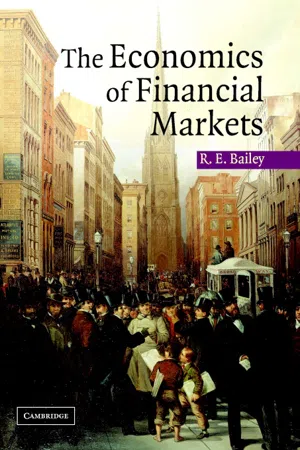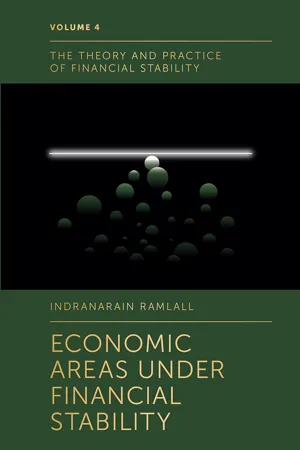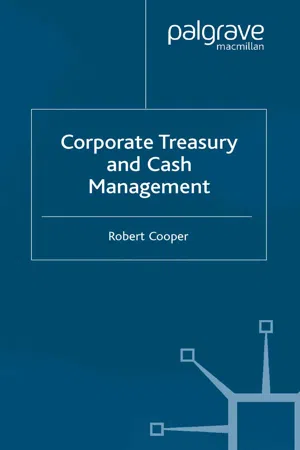Economics
Hedging Derivatives
Hedging derivatives are financial instruments used to mitigate or offset the risk associated with price fluctuations in assets such as commodities, currencies, or securities. They allow investors and businesses to protect themselves from potential losses by locking in prices or rates for future transactions. Common types of hedging derivatives include options, futures contracts, and forward contracts.
Written by Perlego with AI-assistance
Related key terms
1 of 5
8 Key excerpts on "Hedging Derivatives"
- Manolis G. Kavussanos, Dimitris A. Tsouknidis, Ilias D. Visvikis(Authors)
- 2021(Publication Date)
- Routledge(Publisher)
The core function of the financial system is to facilitate the allocation and development of economic resources, both spatially and across time, in an uncertain environment (Merton, 1990). The economic function of financial markets can be seen in three dimensions: time, risk and information. The intertemporal (over time) nature of financial decisions implies uncertainty as to the future outcomes of key variables, such as equity prices, foreign exchange rates, interest rates, commodity prices, freight rates, etc. This uncertainty encompasses the possibility of a financial loss. For instance, an oil refinery does not know in August what price it will have to pay in October for crude oil to continue its refining operations. The possibility of a rise in the crude’s price by October constitutes a risk for the refinery, as this will increase its input costs. Money and capital markets provide a wide range of instruments or institutional arrangements to either diversify away risks (hedge), i.e. to reduce or eliminate risks, or to (re)allocate the undiversifiable part of the risks among households and companies, from those who want to avoid it to those who are willing to accept it for an expected return.The origin of the term “hedging” is unclear, but it appears to derive from the use of hedges to form a protective or defensive barrier around property. In a business context, the term means “to secure oneself against a loss on an investment by investing on the other side” (Arditti, 1996). Hedging is insuring (protecting) against changes in the market, so that the buyer or seller in the market is protected against adverse changes in prices in the future.1 Before implementing a hedge, various issues should be considered: Identification of the potential risk exposure, calculation of the risk exposure, selection of the appropriate hedging instrument, calculation of the size of the hedge, and finally monitoring of the hedge. The available methods of hedging depend upon the form of risk and the investors’ preferences. Companies and individual investors can use modern risk management instruments, such as financial derivatives, in order to hedge their risks. Financial derivatives are contracts which have a price. This price depends, amongst other things, on the value of the underlying asset upon which the contract is written. Hence the name derivative – its value derives from that of another asset, known as the “underlying asset” or the “underlying commodity- eBook - PDF
Corporate Finance
Theory and Practice in Emerging Economies
- Sunil Mahajan(Author)
- 2020(Publication Date)
- Cambridge University Press(Publisher)
This is termed hedging. A hedge is any action that eliminates/ reduces the price risk of an existing or anticipated position in the cash market. The hedged position in the derivatives is the opposite of the existing spot-market position. A long position in the spot market such as holding a portfolio of securities can be hedged with a short position in the forward/futures market. This position is termed a short hedge. A short futures hedge is appropriate when the investor will sell an asset in the future and wants to lock in a price. Similarly, a short position in the spot market such as a company requiring the import of capital goods for a forthcoming project investment can be hedged with a long position in dollar futures. This position is termed a long hedge. A long futures hedge is appropriate when the company will purchase an asset in future and wants to lock in a price. Options, of course, enable the hedging of losses while gaining from the profits in the cash market. Financial Derivatives | 253 Hedging Mechanics Derivatives are instruments to hedge risk which implies the following: 1. There must be an underlying risk in the spot market, which creates a need to hedge. The risk arises in the spot market as a part of the fundamental business of a company. 2. Hedging does not change the risk inherent in the spot position which remains unaltered. The basic characteristics of the spot-market position do not change nor do its outcomes. 3. Hedging involves taking a contrary position in the futures/forward contract with the same/ similar variable as the underlying. The hedge negates the impact of the change in the price of the variable in the spot market. There is a need to appreciate the hedging mechanics pertaining to futures. Futures are primarily instruments to hedge risk. Futures can be effectively used by understanding the nature of the risk which an organization or an individual face in the spot market. - eBook - PDF
- Roy E. Bailey(Author)
- 2005(Publication Date)
- Cambridge University Press(Publisher)
Historically, hedging has been applied to trading physical commodities (e.g. cotton, wheat or pork bellies), but now it is common to apply it in the context of a wide variety of financial instruments (see chapter 16 for examples). In the remainder of this chapter futures contracts form the hedge instrument (or hedge asset ). The hedge is adopted in order to avoid price fluctuations in what is referred to below simply as ‘the asset’. Thus, for example, wheat futures contracts with maturity date next October could form a hedge instrument against fluctuations in the price of wheat (‘the asset’) intended for delivery in October. In principle, other financial instruments (e.g. forward contracts or options) could play the role of hedge instruments, though only futures contracts are considered in this chapter. (See chapter 20 for a sketch of options as hedge instruments.) A short-hedge refers to the sale of the hedge instrument. A long-hedge refers to the purchase of the hedge instrument. Of course, whether or not any particular Futures markets II: speculation and hedging 367 transaction in futures is part of a hedge strategy depends on the investor’s other commitments or opportunities. 15.2.2 Hedging in practice In an influential paper Working (1962) challenges the description of hedging outlined above. He points out that investment strategies in futures markets rarely fall into the neat categories of arbitrage, speculation and hedging – they often comprise elements of at least two, if not all three, motives. Here is Working’s taxonomy. 1. Carrying-charge hedging . This is essentially an arbitrage strategy in which the investor chooses to hold stocks and then hedges against the risk of price changes in the future. However, in the presence of storage costs and convenience yields, the strategy is not entirely risk-free. (See chapter 14, especially page 349.) Thus, carrying-charge hedging constitutes an imperfect hedge. - eBook - ePub
- Indranarain Ramlall(Author)
- 2018(Publication Date)
- Emerald Publishing Limited(Publisher)
Thus, the higher the degree of funds deficiency of the firm, the higher will be the level of external financing needed to fulfil the project. And herein, comes the key role of derivatives. Through the proper use of derivatives whereby posited expectations of the hedger materialise, then hedging generates savings from these undesired losses which can be employed to meet part of the cash deficiency of the firm in its investment, thereby driving down the extent of need for external financing, all paving the way towards higher value of the firm. Therefore, derivatives are of great assistance to cash-deficient firms which are endowed with positive net present value projects, all trailing behind lower underinvestment effects.4.5. Managers’ Motives to Hedge
4.5.1. Managerial Risk Aversion
Smith and Stulz (1985) showed that managers who had higher stock ownership preferred more risk management while those who had higher option holdings preferred less risk management.4.5.2. Signalling Managerial Skill
DeMarzo and Duffie (1995) and Breeden and Viswanathan (1996) argued that higher ability managers hedged while lower ability managers hedged when the ability difference between them was low and they did not hedge in the case of high ability difference. The reason is based on the fact that managers had concerns about their reputations. Hence, superior managers will hedge risks to sport their skills to outsiders.4.6. Alternatives to Hedging
The empirical evidence points out that firms can still hedge without using derivatives by clinging to alternative non-derivative forms of hedging such as operational or financial strategies. Financial strategies incorporate the use of foreign debt, application of reduced dividends, issuance of convertible debt, issuance of preferred stock and the holding of more liquid assets. Apart from financial strategies, a firm can also use operational strategies to hedge. Operational strategies include the building of production plant in the country which is the source of foreign currency risk. However, no empirical evidence has really been carried out to find out the significance of operational strategies as alternatives to derivatives use. - eBook - PDF
- Brian Kettell(Author)
- 2001(Publication Date)
- Butterworth-Heinemann(Publisher)
11 Derivatives: what do you need to know about economics to understand their role in financial markets?† What are derivatives? Derivatives are contracts which give one party a claim on an underlying asset (derived from the cash value of an underlying asset) at some point in the future, and bind a counterparty to meet a corresponding liability. The contract might describe an amount of currency, a security, a physical commodity, a stream of payments, or a market index. It might bind both parties equally, or offer one party an option to exercise it or not. It might provide for assets or obligations to be swapped. It might be a bespoke derivative combining several elements. Whether deriv-atives are or are not traded on exchanges, their market price will depend in part on the movement of the price of the underlying asset since the contract was created. The rapid growth of derivatives trading around the world in recent years has been propelled by the internationalization of capital markets in general, by technological advances in computers and telecommunications, and by the increasingly fierce competition among big banks and securities houses to devise and sell products. † The contents of this chapter are discussed in more detail in Kettell, B. (2001) Financial Economics. Financial Times–Prentice Hall. Derivatives: what do you need to know about them? 241 Where did derivatives come from? Trading in derivative contracts has a long history. The first recorded accounts of derivative contracts can be traced back to the philosopher Thales of Miletus in ancient Greece, who, during winter, negotiated what were essentially call options on oil presses for the spring olive harvest. De la Vega reported in 1688 that options and futures, or ‘time bargains’ as they were then known, were trading on the Amsterdam Bourse soon after it was opened. Evidence also suggests that futures contracts for rice were traded in Japan in the 17th and 18th centuries. - eBook - PDF
- R. Cooper(Author)
- 2003(Publication Date)
- Palgrave Macmillan(Publisher)
PART III The Use of Derivatives to Manage Risk Different organizations are exposed to a wide range of different risks. In addition to common risks such as foreign exchange and interest rate risk, other risks can range from exposure to the commodity markets and the purchase of power through to exposure to the weather and equity markets. Many such financial risks are managed through the use of derivatives. An effective use of derivatives by a corporate treasury department involves a thorough knowledge of both the markets in which the relevant derivatives are priced and the pricing and structure of those derivatives. Chapters 9 and 10 cover the use of derivatives to manage foreign exchange and interest rate risk. How do these markets work, how are assets priced in these markets, what derivatives are available to manage these risk and how should a treasury department use such derivatives? Banks display great ingenuity in structuring different derivatives; how should such derivatives be analyzed? In addition, two chapters in this section look at the mechanics of some derivatives. Chapter 8 gives a broad overview of options, the different options available and the principal elements involved in pricing an option. Chapter 11 provides a summary of how zero coupon rates are calculated, how they are used to value interest rate swaps and how forward rates are calculated. In addition it contains a brief summary of the legal documentation to which derivative contracts are subjected. The spreadsheets on the CD attached to this book are designed to provide practical guidance, through case studies, as to how derivatives can be used to manage foreign exchange and interest rate risk. Further examples provide guidance on the calculation of zero coupon rates and the use of FX swaps. INTRODUCTION An explanation of the mathematical basis and methodology used in the calculation of option prices is generally well outside the scope and require- ments of most corporate treasurers. - Benjamin Lee, Edward LiPuma, Dilip Parameshwar Gaonkar, Jane Kramer, Michael Warner, Dilip Parameshwar Gaonkar, Jane Kramer, Michael Warner(Authors)
- 2004(Publication Date)
- Duke University Press Books(Publisher)
Their earliest forms were futures contracts whose underlying asset was a production-based bulk commodity; more recently, in response to global-izing markets, the underlying asset classes have included cur-rencies, stocks, bonds, performance indexes, and also other derivatives. A critical dimension of derivatives is that they do not involve the immediate exchange of principal and, ac-cordingly, are not immediately counted on financial balance sheets, so that especially when financial agents combine dif-ferent types of derivatives they allow for an extraordinary and unprecedented degree of leverage. So relatively small wagers can move much larger financial mountains, or more to the contemporary point, relatively large cumulative bets can re-value the currencies of entire countries. A defining feature of derivatives is that they exist in a kind of temporal parenthe-sis, beginning and terminating at a pre-specified moment, in most instances closing out the transaction at an agreed-upon date and time. Nonetheless, the formal economic definition of the deriva-tive—which encompasses any contract whose rate of return is determined by a continuously measurable underlying as-set or performance index (Rubinstein 1987)—conflates types of financial instruments critically different in terms of their basic design, forms of objectification of risk, temporality, and more generally the underlying world of social and semiotic relations upon which they are ultimately founded. On the surface, financial derivatives differ at the general (type) and individual (token) levels. They differ generally at the level of type according to the forms of arbitrage and hence the form of assets that they are designed to exploit: the relationship 108 among currencies, interest rates, indexes, and so on. There is nothing inherently commensurable between, for example, interest rates and stock indexes.- eBook - PDF
- A. Clare, C. Wagstaff(Authors)
- 2011(Publication Date)
- Palgrave Macmillan(Publisher)
They can of course be used to enhance this risk recklessly too, but it is to be hoped that trustees do not have this goal in mind! We also considered credit default swaps. These are the building blocks of many credit derivative instruments, and again can be used for risk management purposes, though again in the wrong hands could become the catalyst of economic disaster. Key points For many uninformed commentators, derivatives represent the worst excesses of ‘casino capitalism’. However, when used properly, derivatives can aid risk management. Derivatives can be used to increase exposures to market risk very rapidly and cheaply, facilitate a move from one investment exposure to another more safely and more efficiently than by using the ‘cash’ market and as a means by which to hedge cash market exposures. Embedded in a derivative contract is normally a ‘zero sum game’, that is, for every gain for one investor, there is an equal and opposite loss for another. Forwards and futures are obligations and are analytically very similar except that forwards are bespoke, over the counter (OTC) contracts and futures are standardized and exchange traded. By contrast, for the buyer of an option, options represent a right not an obligation. For the seller, however, they represent an obligation. Options can be traded OTC or on an exchange. Credit default swaps can facilitate access to an underlying credit market, without the need for a significant cash investment and provide protection against a bond, or portfolio of bonds, defaulting. • • • • • •
Index pages curate the most relevant extracts from our library of academic textbooks. They’ve been created using an in-house natural language model (NLM), each adding context and meaning to key research topics.







